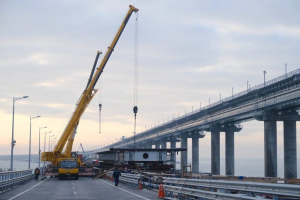Crimean bridge
The Crimean Bridge, an engineering marvel spanning the Kerch Strait, stands as a testament to human ingenuity, bridging not only physical distances but also historical and geopolitical divides. With a length of approximately 19 kilometers, the bridge complex connects the Crimean Peninsula to the Taman Peninsula of Russia, opening up new avenues for trade, travel, and cultural exchange. In this blog post, we delve into the fascinating story of the Crimeans Bridge, from its inception to its significance on the global stage.
A Bridge Across Time and Space
The idea of a bridge connecting Crimea to mainland Russia is not a recent one. In fact, discussions about such a connection date back several decades. However, it wasn’t until 2016 that construction on this ambitious project began in earnest. The engineering challenges were substantial, including the need to build a structure capable of withstanding the region’s harsh climate, seismic activity, and the challenging marine environment of the Kerch Strait.
A Triumph of Engineering
The Crimean Bridge is more than just a physical link; it’s a masterpiece of modern engineering. The complex comprises two main components: a road bridge and a rail bridge. The road bridge accommodates a wide range of vehicles, from cars to trucks, while the rail bridge facilitates the transportation of goods and passengers by train. The construction process involved innovative techniques and materials, showcasing the prowess of Russian engineering expertise.
Opening Up New Horizons
One of the primary motivations behind the construction of the Crimeans Bridge was to enhance connectivity and promote economic development in the Crimean Peninsula. Prior to the bridge’s completion, access to Crimea was primarily dependent on ferry services, which could be unreliable and limited in capacity. The bridge has revolutionized transportation, enabling a more efficient flow of goods and people, stimulating tourism, and attracting investments to the region.
Geopolitical Considerations
The Crimeans Bridge has not only transformed physical infrastructure but has also played a role in shaping geopolitical dynamics in the region. Its construction occurred against the backdrop of Russia’s annexation of Crimea in 2014, a move that sparked international controversy and condemnation. Critics argue that the bridge serves to solidify Russian control over the peninsula, further complicating the already intricate political landscape.
Environmental Impact and Sustainability
Any large-scale infrastructure project raises questions about its environmental impact. The Crimeans Bridge is no exception. Environmentalists have expressed concerns about potential disruption to marine ecosystems, alteration of water flows, and other ecological effects. However, proponents of the bridge emphasize its potential to boost the local economy and argue that steps have been taken to mitigate environmental risks.
Cultural Exchange and Integration
Beyond its economic and geopolitical implications, the Crimeans Bridge has contributed to cultural exchange and integration between different regions. As people and goods move more freely, cultural interactions and exchanges are bound to increase, fostering a deeper understanding between communities that were previously more isolated from each other.
Looking Ahead
The completion of the Crimeans Bridge marks a significant milestone in the region’s history. It symbolizes the triumph of human determination over challenges, both technical and political. As the bridge continues to facilitate interactions between Crimea and Russia, it will undoubtedly remain a subject of fascination, debate, and discussion for years to come.

Challenges and Innovations in Construction
The construction of the Crimean Bridge was not without its share of challenges. The engineering team had to contend with the region’s extreme weather conditions, including freezing temperatures and strong winds during the winter months. Additionally, the bridge had to be designed to withstand potential seismic activity in the area. These challenges prompted the use of advanced construction techniques and materials, pushing the boundaries of modern engineering. Also, read about Recent Developments in Ukraine’s Military News
Innovations in bridge design were also crucial. The team incorporated state-of-the-art technologies to ensure the bridge’s stability and longevity. Advanced simulation models were used to predict the bridge’s behavior under various conditions, aiding in the optimization of its design. These innovations not only contributed to the successful completion of the project but also added to the body of knowledge in civil engineering.
Economic Impacts
The Crimeans Bridge has had a profound impact on the economic landscape of the region. By providing a direct transportation link, it has facilitated the movement of goods and people, reducing transportation costs and boosting trade. This improved connectivity has led to increased investment in the Crimea Peninsula, as businesses see the potential for growth and expansion. The bridge has also spurred the development of new infrastructure, including road networks and logistical facilities, further enhancing the region’s economic prospects.
Tourism and Cultural Exchange
Tourism has experienced a significant uptick since the bridge’s completion. The easier accessibility to the Crimean Peninsula has attracted tourists from both within Russia and abroad. Visitors now have the opportunity to explore the rich cultural heritage, historical sites, and picturesque landscapes that the region has to offer. As a result, the bridge has become a conduit for cultural exchange, allowing people to connect, share experiences, and appreciate the diversity of the region.
Environmental Considerations
The environmental impact of large-scale infrastructure projects is a topic of concern and debate. While the Crimeans Bridge has undoubtedly brought about positive economic and social changes, it’s important to address its potential ecological effects. Environmental monitoring and mitigation efforts have been put in place to minimize harm to marine ecosystems and surrounding habitats. The challenge moving forward is to ensure that sustainable practices are upheld and that any negative consequences are managed effectively.
Diplomatic and Geopolitical Repercussions
The construction and operation of the Crimeans Bridge have not been isolated from international politics. The geopolitical implications of the bridge extend beyond its physical structure. Some countries and international organizations have expressed concerns over the bridge’s connection to the disputed status of Crimea. As such, the Crimeans Bridge serves as a focal point for discussions on sovereignty, regional stability, and diplomatic relations.
Future Expansion and Connectivity
The completion of the Crimeans Bridge marks a significant step in enhancing connectivity for the region, but it might also pave the way for future developments. Discussions are underway about the potential for further expanding transportation networks, including the integration of the bridge into larger regional infrastructure projects. These developments could have far-reaching implications, promoting not only regional connectivity but also broader economic integration.
A Symbol of Resilience and Progress
Beyond its physical attributes, the Crimean Bridge has become a symbol of resilience and progress. It stands as a testament to the capacity of human beings to overcome challenges and achieve remarkable feats of engineering. The bridge’s completion serves as a source of inspiration, demonstrating what can be achieved through determination, innovation, and international collaboration.

Conclusion
The Crimeans Bridge represents more than just a connection between two land masses. It embodies a complex web of economic, political, environmental, and cultural considerations. As the bridge continues to shape the region and influence global discussions, it will remain a topic of interest and inquiry, prompting us to reflect on the intricate interplay between infrastructure, society, and the world at large. The Crimeans Bridge stands as a symbol of progress, connecting two landmasses while bridging historical divides. Its construction exemplifies human ambition, innovation, and the capacity to overcome obstacles.
FAQs
How long did it take to build the Crimean Bridge?
The Crimean Bridge was completed in a remarkably short time, taking approximately three years from start to finish.
What are the economic benefits of the Crimean Bridge?
The bridge has boosted economic growth by facilitating trade, commerce, and infrastructure development in the region.
Why is the Crimean Bridge significant geopolitically?
The bridge’s strategic location holds geopolitical implications, potentially influencing regional dynamics and power balances.
Has the Crimean Bridge increased tourism in the region?
Yes, the bridge has made the Crimean Peninsula more accessible, leading to an increase in tourism and interest from travelers.
What measures have been taken to ensure the bridge’s environmental sustainability?
Environmental considerations are integral to the bridge’s ongoing development, with efforts to minimize ecological impact and promote sustainability.
